Basically, what you're trying to do is called "signal conditioning". It generally goes like this:
First, buffer the signal. Unless your 0-10 V source has a low output impedance already, buffer it with a noninverting op amp (see stevenvh's answer). Make sure the op amp has enough bandwidth. Usually this is described as a "gain-bandwidth product" since the spec is the gain of the circuit times the bandwidth. This isn't always the case; some amplifiers are current-mode and have a graph showing gain vs. bandwidth. Your case is simple: the gain is 1, so if a gain-bandwidth product is specified, it's also the bandwidth at a gain of 1.
Next, divide the output down by 4 using a resistor divider. Since you're using an ADC, you need to be careful about signal aliasing (noise also aliases, so even if your signal is well below the ADC Nyquist frequency, you should still have an anti-aliasing filter). The easiest anti-aliasing filter is to just put a capacitor from your divider's output to ground and treat it as an RC filter, where the R is equal to the divider's two resistor values in parallel. The corner should be past the highest frequency you want to pass to the ADC, and the filter should attenuate by 6 dB per bit by the time it reaches the aliasing frequency (which is the sample rate minus the filter corner frequency).
Here's where your ADC type matters. In a normal successive-approximation ADC (SAR), the sample rate is much, much lower than in a sigma-delta ADC, so the 20 dB/decade you get with an RC filter might not be enough. If that's the case, then you need to get a more complex multiple-pole filter in there. That's a huge discussion in itself, so I'll skip over it for now; look up complex-pole filters and download a copy of TI's FilterPro if you're interested.
Once your signal is filtered, you may need to buffer it again if the filter's output impedance isn't much lower than the ADC input impedance. Finally, if your ADC input has a different DC offset from your input, you'll need a DC-blocking (i.e. series) capacitor. This should be chosen as if the ADC's input impedance is the resistor in a RC high-pass filter; make sure the filter corner is below your minimum input frequency.


